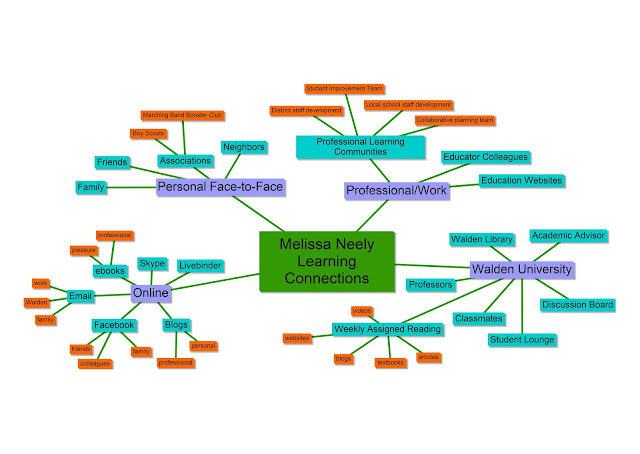Learning Theories and
Instruction has certainly deepened my understanding of learning theories. Even though I’ve been an elementary teacher
for eight years, my teacher certification training did not include much in the
way of theory. I feel that a renewed
focus on learning theories, learning styles, technology, and motivation have
already benefited me in the classroom.
One area of the course that
intrigued me was Siemens’ Connectivism.
We are exposed to an overwhelming amount of information on a daily
basis. Connectivism helped me to
understand the connection between this abundance of information, the need to
offload our cognitive capacity on networks, and the use of technology to
connect with networks of people and data (Laureate Education, 2009). The mind maps we created helped me to
visualize and understand the connections of my personal network.
Throughout the course, I’ve
had the opportunity to reflect upon myself as a learner. As we studied cognitive theories, I realized
that I learn more effectively when I’m an active participant in the learning,
and when I’m given the opportunity to apply that knowledge (Ertmer & Newby,
1993). When I’m learning, I like to see
the big picture, the instructional goal, but I also need the material broken
into manageable chunks with smaller goals set along the way (Laureate
Education, 2009). Accomplishing smaller
goals along the way helps me to stay focused and avoid becoming overwhelmed. I also realized through our course readings
that the feeling of isolation that I have experienced is a common problem among
distance learners (Huett, 2008). Acknowledging
this has helped me see the benefit of creating new networks to feel more
connected in my virtual classroom. As
this is only the second course in the program, I also realize that this is part
of the distance learning/online adjustment period.
One “light bulb” moment (that’s
what we call it in my classroom) that I had during the course was that I cannot,
and should not, try to constantly adjust my teaching style to meet the needs of
each individual’s learning style. Instead
of designing this learning experience to reach visual learners and that
learning experience to meet kinesthetic learners, it is more effective to
consider the content and the best way to present the given material. We also spent time during this course
considering what technology could be used to present material or assist
students in the learning process.
Reading The Horizon Report
about up and coming technology was both exciting and intimidating. The ways in which teachers and instructional
designers create learning experiences will continue to expand with 1:1
technology, gaming, cloud-based applications, and even learning analytics with
its goal of tailoring learning experiences to meet a student’s needs and
abilities in close to real-time (Johnson, 2012). We can put fabulously designed, technology-enhanced
learning experiences in front of students, but are the students motivated to
learn? As we read this week, distance
learning provides its own unique challenges to instructors and designers
attempting to motivate students (Huett, 2008).
We know that some people are more intrinsically motivated than others,
but it is encouraging to learn that as instructors and designers, the learning
environment we create can impact “both the direction and intensity of a
person’s motivation (Keller, 1999).
Through this course, I’ve
learned more about blogging and created my own blog. I learned about RSS readers and plan to
continue expanding my knowledge of their use.
Both blogging and an RSS reader will help me stay better connected to
the fields of education and instructional design. I’ve also gained a deeper understanding into
the ways in which people learn and different strategies to help them learn. Of course, woven through all of the theories
and strategies is the use of technology in education. These are all considerations that I will take
with me as I continue on my journey of completing my master’s and becoming an
instructional designer.
References
Ertmer,
P.A. & Newby, T.J. (1993).
Behaviorism, cognitivism, constructivism: Comparing critical features from an
instructional design perspective. Performance Improvement Quarterly, 6(4),
50-71.
Huett,
J., Moller, L., Young, J., Bray, M., & Huett, K. (2008). Supporting the
distant student: The effect of
ARCS-based strategies on confidence and performance. Quarterly Review of Distance Education, 9(2), 113–126.
Johnson,
L., Adams, S. and Cummins, M. (2012). The
NMC Horizon Report: 2012 Higher
Education Edition.
Austin, TX: The New Media Consortium. Retrieved from http://net.educause.edu/ir/library/pdf/HR2012.pdf
Laureate Education, Inc. (2009). Behaviorism and
Instructional Design.
[Video Podcast]. [With Dr. Jeanne Ormrod].
Laureate
Education, Inc. (2009). Connectivism.
[Video Podcast]. [With George Siemens].
